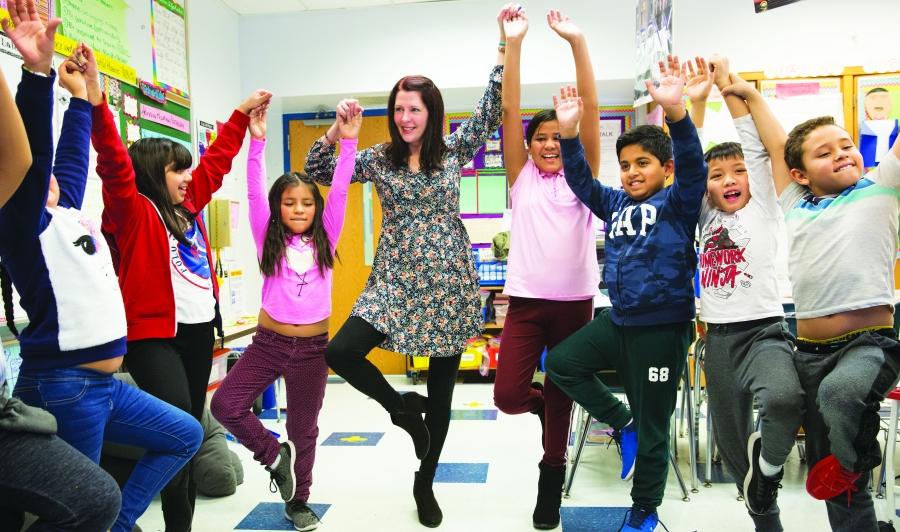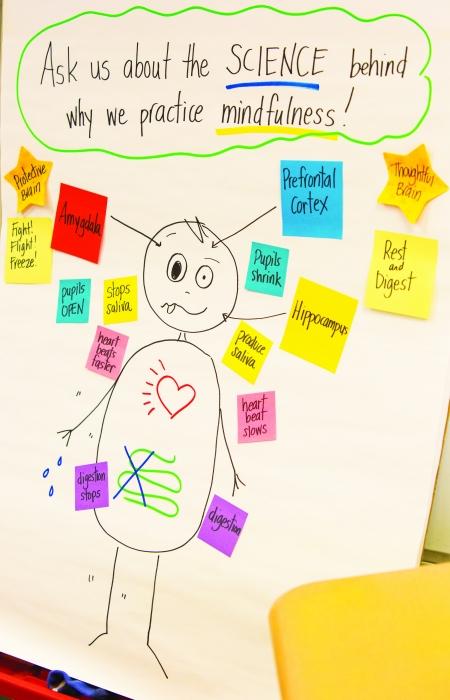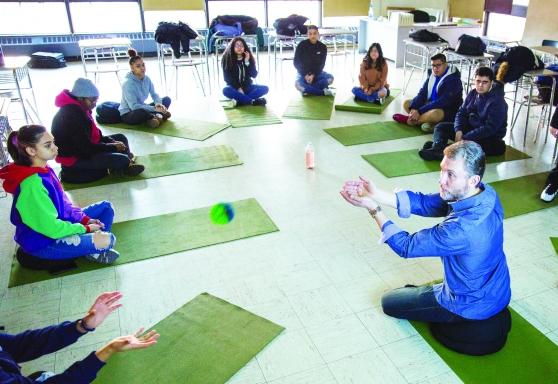
Danielle Mahoney, the literacy coach and Teacher Center site director at PS 212 in Jackson Heights, Queens, helps her 4th-graders “wake up their bodies” during their period of mindfulness practice.

Mahoney’s students discuss how the parts of their bodies react to stressful situations and how mindfulness can help them cope.
If you've ever been in a visible state of distress, chances are good someone has told you to take a deep breath. Why? Because breathing deeply activates a set of neurons in the brain that relaxes your body.
Without knowing it, you were drawing on the practice of mindfulness. Mindfulness asks us to be more aware of ourselves — such as our breathing patterns — and to use that awareness to regulate our emotions.
In the past few years, mindfulness exercises like meditation and breathing techniques have become popular at many schools. But mindfulness is more than a few minutes spent breathing deeply with your eyes closed. Educators who practice mindfulness with their students emphasize that their goal is to teach students how their brains and bodies work together — and give them the tools to cope with challenging situations by practicing techniques attuned to that brain-body connection.
"If you're a human being with a brain and a nervous system, mindfulness can help you understand how they work," says Danielle Mahoney, the literacy coach and the UFT Teacher Center site director at PS 212 in Jackson Heights, Queens. "The nature of a mindfulness practice is being able to deal with the things life throws at you by helping you be aware of what's happening in your body and giving you space for what happens next."
All of us experience biological responses to stress in our bodies — stomach and head pain, dry mouths, sweaty palms. Mindfulness can help students become aware of how their bodies feel when they're calm and how their bodies respond when they're stressed so they can develop appropriate coping mechanisms.
"That's your nervous system trying to protect you," Mahoney says. "When we see a student feeling big feelings, telling them to calm down or not cry doesn't work. If they have a mindfulness practice in place, they can notice that feeling in their body and do something that's thoughtful, instead of a knee-jerk response."
Mahoney likens practicing mindfulness with young students to teaching them how to swim in shallow water before venturing into the depths. Just like novice swimmers, children need regular practice with strategies for confronting difficult feelings so they can draw on them in a true crisis.
In a recent session with 4th-graders, for instance, Mahoney and her students discussed the function of different parts of the brain in times of stress.
"The amygdala alarms you," said one student.
Then, Mahoney modeled a new practice for students, guiding them to notice where their thoughts drifted and determine whether they were thinking about the past, present or future.
"When we take the time to tune into what our brain is doing and notice where our thoughts go, it helps us focus and gently bring our attention back to the present moment," she told them.
For Brian Simmons, an English teacher and the dean at Food and Finance HS in Hell's Kitchen in Manhattan, practicing mindfulness with students can do more than help them cope with stress. It can transform the very essence of how they see themselves.
"It's a scaffolded journey that takes teenagers who may not be so aware of themselves or feel a sense of control over themselves and provides them with the tools and knowledge to become a more focused, happier person," he says.
At Food and Finance, nearly all of the school's 375 students will take Simmons' "mindful fitness" class before they graduate. Simmons says his unique curriculum is designed to help students practice what science preaches.
"Everything we do here has a root in science," Simmons tells a group of teenagers who are lying on their backs on yoga mats. They watch a video on "the science of kindness," which explains that our bodies release positive hormones — seratonin, endorphins and oxytocin — when we perform acts of kindness. Then the students practice a "kindness meditation" by visualizing benevolent thoughts about a loved one.
"We've learned about neuroplasticity, about how our brain changes," Simmons reminds them. "Mindfulness rewires the brain."
Simmons says Food and Finance has seen a dramatic decrease in student suspensions since the school adopted mindfulness alongside restorative justice practices as part of its culture.
"At our school, we emphasize career readiness, and I can't think of any skills more suited to success than self-discipline, self-awareness, kindness, compassion and focus," Simmons says. "Mindfulness bakes these skills into our students to give them more resilience and presence."
